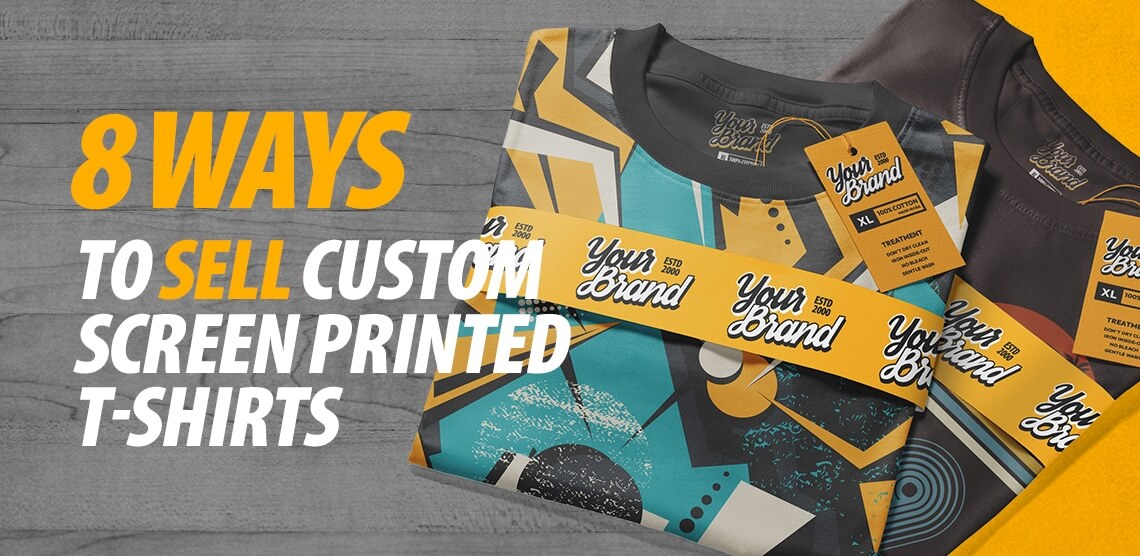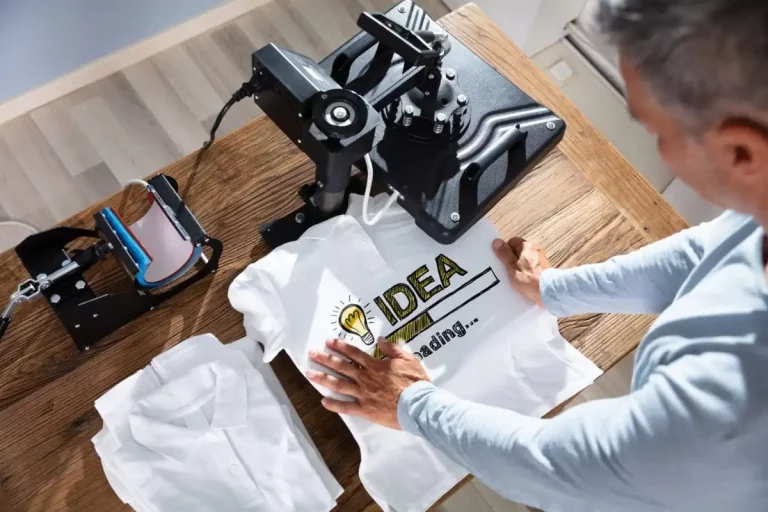Display Printing Uncovered: Whatever You Need to Understand About T-Shirt and Garment Printing Methods
Display printing is a remarkable approach that incorporates art with strategy, supplying countless opportunities for imagination. All set to discover the essential components that make display publishing an art type?
The Basics of Display Printing: Just How It Functions
When you plunge right into screen printing, you'll discover it's both an art and a science. At its core, screen printing includes developing a stencil, or screen, that permits ink to pass with just in particular areas.
Following, you'll mix your inks and prepare your printing surface area. Placement the screen over the fabric, after that utilize a squeegee to press ink with the screen onto the garment. This process calls for precision, as you want clear, lively prints. After printing, you'll cure the ink with warm, guaranteeing it follows the fabric and lasts with washes. Each action is crucial, and grasping them will certainly raise your screen printing skills, changing simple garments right into special, expressive pieces.
Kinds Of Display Printing Strategies
Once you understand the fundamentals of display printing, it's time to discover the different techniques that can raise your styles. One preferred method is typical display printing, where ink is pressed through a stenciled screen. This method is great for bold, dynamic shades. There's water-based ink printing, which offers a softer feeling and is environmentally friendly, however it calls for a various method to curing.
An additional choice is plastisol printing, understood for its longevity and brilliant colors, making it a favored for many brand names. Experiment with halftone printing to produce slope impacts and complex styles.
Vital Equipment for Screen Printing
To attain spectacular outcomes in screen printing, having the ideal tools is basic. You'll require a durable display printing structure, which holds the mesh that moves your layout onto the garment. Next off, invest in premium mops; these are necessary for using ink equally throughout the display.
Choosing the Right Inks and Materials
When selecting inks and materials for display printing, you require to take into consideration the kind of ink that functions ideal for your job. Think concerning fabric compatibility to assure your designs look last and fantastic long. Additionally, discover environmentally friendly ink options to make your printing procedure more sustainable.
Types of Display Inks
Choosing the ideal screen ink is important for accomplishing lively, sturdy prints that satisfy your job's needs. There are a number of kinds of display inks to take a look at. Plastisol ink is preferred for its convenience and simplicity of usage, giving superb color opacity on dark materials. Water-based ink, on the various other hand, supplies a softer feeling and is environmentally friendly, making it excellent for those seeking to lessen their environmental influence. Release inks eliminate color from the textile, leading to a soft, classic appearance yet require specific handling. Finally, specialized inks, such as metal or glow-in-the-dark, can add distinct effects to your designs. Review your task demands and pick the ink that aligns best with your wanted outcome.

Fabric Compatibility Considerations
Understanding textile compatibility is important for attaining high-grade display prints, specifically because different materials respond uniquely to different inks. When choosing inks, think about the fabric type-- cotton, polyester, or blends. For cotton, water-based inks function well, offering gentleness and breathability. Polyester, on the other hand, commonly needs plastisol inks for better adhesion and lively shades. If you're printing on blends, you may require to utilize a mix of both kinds. Always check your inks on sample textile to ensure they stick correctly and keep shade integrity. Furthermore, keep in mind that textile weight and appearance can affect the last result, so picking the best ink and product combination is essential for your job's success.
Eco-Friendly Ink Options
Environment-friendly inks are becoming a preferred choice for display printers that desire to reduce their ecological effect while preserving quality. When selecting inks, consider water-based inks, which are less harmful and easier to cleanse up contrasted to traditional solvents.
Additionally, try to find inks made from sustainable resources, such as soy or vegetable-based options. By selecting the best inks and products, you'll not just produce stunning styles yet also add to a great site much more sustainable printing procedure. Make the button, and your prints will show your dedication to the environment!
Preparing Your Style for Screen Printing

Submit Style Demands
To guarantee your design looks sharp and lively on material, you'll need to pay close attention to submit style requirements for display printing. Make sure your design has a transparent background to protect against undesirable white edges on your prints. Maintain shade settings in mind; CMYK is basic for screen printing, so convert your RGB designs as necessary.
Color Splitting Up Strategies
Color separation is a necessary action in preparing your style for display printing, and grasping it can significantly improve your print quality. You'll require to break your style right into private shades, as each shade calls for a different display during printing. Start by recognizing all the colors in your style and create layers for each one. You can make use of software like Adobe Photoshop or Illustrator to isolate and different colors successfully. Be specific to save each layer as a different documents, normally in a style like TIFF or PSD. This precision not just assures her explanation exact color representation yet also improves the printing process. By taking notice of shade splitting up, you'll accomplish dynamic and specialist outcomes in your screen-printed garments.
Resolution and Dimension
Accomplishing the very best cause screen printing starts with assuring your design has the right resolution and dimension. Ideally, your art work needs to go to the very least 300 DPI (dots per inch) for sharp, clear prints. If you use reduced resolution, your end product may look pixelated and less than professional.
When it involves dimension, think about the dimensions of your print area. Layout your art work to match the last print size, ideally producing it in the real dimensions you'll be printing. This way, you'll stay clear of any unforeseen scaling issues.
Always inspect your layout in both vector and raster formats. Vector graphics can be scaled without losing high quality, making them optimal for screen printing. Preparing correctly will guarantee your layout looks impressive on every garment!
Step-by-Step Display Printing Refine
Display printing is a dynamic procedure that permits you to produce lively styles on different surface areas. To obtain started, you'll need a screen, solution, and your picked ink.
Put ink onto the display and utilize a image source squeegee to push the ink via the stencil onto the fabric. Raise the display thoroughly and let the print completely dry. You've effectively display printed your layout.
Tips for Successful Display Printing Projects
While you're diving right into your screen printing projects, bear in mind that preparation is vital to success. Beginning by gathering all your products-- inks, garments, displays, and squeegees. A tidy office helps protect against undesirable mistakes, so clean prior to you start.
Following, verify your art work is high-resolution and correctly sized for your garment. Test your screen for appropriate direct exposure and clean it thoroughly to prevent smudges. When mixing your inks, adhere to the producer's guidelines to attain the best uniformity.
During printing, use also stress with your squeegee for constant outcomes. Don't rush; take your time to validate each print fulfills your standards. After printing, allow your garments completely dry completely prior to managing or packaging them.
Finally, constantly maintain a sample of your benefit future referral. In this manner, you can evaluate your progression and boost your techniques gradually. Satisfied printing!

Regularly Asked Inquiries
How much time Does It Require To Establish a Display Printing Task?
Setting up a display printing job generally takes around 30 mins to an hour. You'll prepare the displays, mix inks, and change the press. The time differs based upon complexity and experience, so stay arranged!
Can I Publish on Various Material Types Using the Very Same Method?
Yes, you can print on different fabric kinds utilizing the same strategy, yet you'll need to adjust your inks and setups. Some materials soak up ink in different ways, so exploring assurances the best outcomes for each material.
What Prevail Errors to Avoid in Display Printing?
When screen printing, prevent typical mistakes like making use of the wrong ink, neglecting appropriate exposure times, or avoiding pre-press checks. Always test your arrangement and preserve clean displays to assure high quality results each time.
Just How Can I Correctly Tidy and Preserve My Screen Printing Tools?
To correctly tidy and preserve your display printing equipment, you ought to frequently wash displays with proper solvents, check mops for wear, and guarantee all devices are stored dry and dust-free. Uniformity prevents expensive repairs and improves performance.
Is Display Printing Ecologically Pleasant Compared to Other Approaches?
Screen printing can be extra ecologically friendly than other methods, specifically if you make use of water-based inks and eco-conscious materials. By picking sustainable materials and methods, you reduce waste and lessen your influence on the planet.
Screen Printing Uncovered: Whatever You Need to Know Concerning Tee and Garment Printing Techniques
At its core, screen printing includes developing a stencil, or display, that enables ink to pass via only in specific locations. Position the screen over the material, then make use of a squeegee to push ink through the screen onto the garment. One popular technique is standard screen printing, where ink is pressed with a stenciled display.When picking inks and products for screen printing, you require to take right into account the kind of ink that functions ideal for your task.